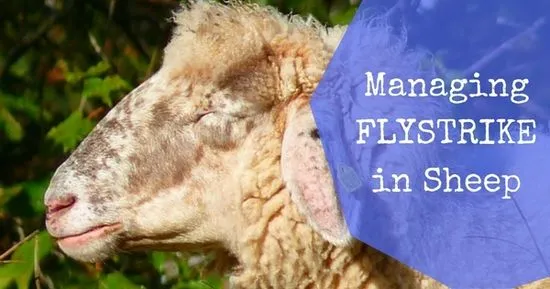$10 off on your first order.
We’ll send you the $10 OFF coupon as soon as you submit your email. Join now for instant savings!

Ah…springtime. Birds cheeping, baby animals frolicking, wildflowers blossoming…blowflies striking? It’s an unpleasant fact that the time of year that many of us enjoy the most can be very uncomfortable and even deadly for our woolly friends.
Flystrike is one of the most important health and welfare concerns for sheep in Australia, particularly in areas experiencing a warm and humid start to spring. When the conditions are right (moisture, temperatures between 15-38 degrees, and low wind) a particular type of Blowfly (in Australia usually the Lucilia cuprina or Australian Sheep Blowfly) is attracted by the smell and moist conditions of soiled wool. This is usually located around the tail or breech area of sheep where dags, urine and faeces stains and scouring (diahorrea) all attract the flies.
Flystrike occurs when the flies’ lay eggs in the damp wool, which quickly develops into maggots. The maggots, which need protein to develop, then feed on the flesh of the sheep. The smell caused by the initial infestation and resulting bacterial infections can attract more flies, to commence the cycle again. While the maggots feed on the flesh they are poisoning their host by secreting ammonia which attacks the heart, lungs, and brain of the sheep. Sheep can die from ammonia poisoning as quickly as 36 days from the onset of the first strike.
Affected sheep will start to show signs of illness only after the maggots have caused enough damage to make the sheep feel uncomfortable. Some signs of infestation are sheep trying to kick or nuzzle at the affected area, appearing restless or fidgety, and loosing interested in grazing. Flystrike will first appear as a discoloured, moist, and smelly area of wool, which contains maggots. As the condition worsens, the fleece darkens and the wound starts to discharge, before wool starts falling out and the sheep stops eating and seek shade.
Inspection
Regular inspection of your sheep is essential for prevention. If your sheep have not been treated with an active preventative chemical, they should be inspected at least every two days if the weather conditions are conducive to infestation. You should keep an eye on treated sheep during wet and warm conditions too, as heavy rain can wash preventative chemicals from the fleece.
Nutrition and worm control
Practice good sheep husbandry by ensuring your sheep have access to clean water and quality pasture, and a worm management regime is in place. This will help prevent scouring which is a key attractor for blowflies.
Mulesing and Docking
Mulesing and tail docking are both surgical procedures and care needs to be taken to ensure the best outcome. Both procedures should be performed by qualified or trained people when lambs are as young as possible, ideally before 3 months of age. Docking refers to removing of part of the tail, usually below the third tail joint. Mulesing involves cutting flaps of skin from around a lamb’s breech and tail to create an area of bare, stretched skin which doesn’t hold on to moisture and faeces. While docking and mulesing have been very effective traditional techniques for preventing flystrike, there is a move away from these invasive techniques towards selective breeding, and they should be only considered when necessary.
Crutching and dagging
Crutching or dagging susceptible sheep can also be effective in removing factors that attract flies. Crutching refers to the removal of wool by shearing from around the tail and between the rear legs of a sheep. Dagging means clipping off any dirty clumps of wool around the rear end of the sheep. Crutching is usually done 2-3 times a year depending on the sheep breed and climate of the farm to prevent flystrike and is also practised when an ewe is about to lamb, so that newborn lambs can attach to their mother’s teat more easily.
Selective breeding
Selective breeding of sheep to reduce susceptibility to flystrike is a long-term solution for reducing incidence of blowfly strike. Sheep are now being breed specifically to reduce wrinkles and folds in their skin and the amount of wax and moisture in the fleece to make conditions less attractive to blowflies. Breeding for increased resistance to worms and scouring is also part of the approach for developing healthy sheep.
If you do notice any initial signs of flystrike in your sheep, you need to act fast. Separate struck sheep from the rest of the flock to reduces the risk of flystrike spreading and to assist with treatment and monitoring.
Flyboss provide the following treatment recommendations:
Reducing susceptibility
Susceptibly of your sheep to flystrike depends on environmental conditions as well as sheep type and management strategies. Agriculture Western Australia lists the best scenarios for reducing the likelihood of flystrike in your flock:
Check out our online store’s Sheep Treatments Section. If you have any questions about fencing, please give us a call on 9651 1312 or drop in to our Moora or Yerecoin store. We are an independent local family-owned Western Australia rural store, and we love sharing our knowledge and experience with our customers.
Further Information:
Join now for instant savings!
$10 off on your first order. Join now for instant savings!
We’ll send you the $10 OFF coupon as soon as you submit your email. Join now for instant savings!